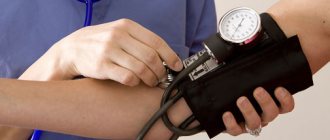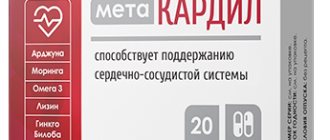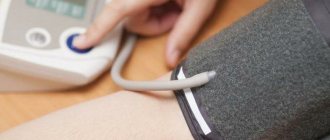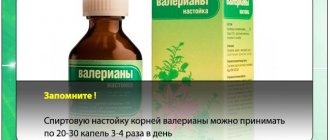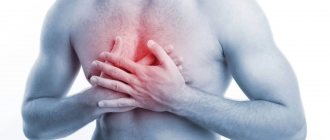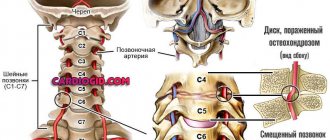How does a hot bath affect the cardiovascular system?
People often ask why you can’t take a bath with hot water at high blood pressure? If, during hypertension, you completely (up to the neck and back of the head) immerse yourself in water heated above 37 ° C, the vessels of the internal organs and the brain expand sharply. This threatens collapse (a life-threatening drop in pressure), and sometimes rupture of blood vessels and hemorrhagic stroke.
In the early stages of hypertension, a contrast shower is useful. When water with different temperatures alternates, the vascular walls are strengthened due to alternate tension and relaxation, and blood circulation improves. When taking a shower, the difference between warm and cold water is gradually increased to train blood vessels and general hardening.
Important
The water in the bath cools at different rates - this must be taken into account. It all depends on the type of bathtub, the material of manufacture and the thickness of the walls. For example, steel bathtubs retain heat much worse than stone ones, and the cooling rate of acrylic ones is average.
This type of hydrotherapy is contraindicated for varicose veins and a tendency to form blood clots. When the blood vessels open, a blood clot can break off and clog the main arteries of the lungs, brain and heart.
For hypertension and even hypertensive crisis, local hot baths are allowed for individual zones. Local vasodilation ensures the redistribution of blood between parts of the body and relieves muscle and vascular tension.
Hot bath: benefits and harms, pros and cons, pros and cons.
High temperature in a child
The child will not say that he has a high temperature. Even relatively older children, including students in elementary school, as a rule, cannot correctly assess their well-being. Therefore, parents need to closely monitor the child’s condition. You can suspect an increase in temperature based on the following signs:
- the child becomes unexpectedly lethargic or, conversely, restless and capricious;
- he is tormented by thirst (he asks for a drink all the time);
- mucous membranes become dry (dry lips, tongue);
- bright blush or, conversely, unusual pallor;
- eyes become red or shiny;
- the child is sweating;
- pulse and breathing increase. The normal heart rate is 100-130 beats per minute while sleeping and 140-160 while awake. By two years, the frequency decreases to 100-140 beats per minute. The normal breathing rate also depends on age; for a two-month-old child it is 35-48 breaths per minute, for an age from one to three 28-35 breaths.
You can measure body temperature in the armpit or groin cavity with a mercury thermometer (it most accurately shows the temperature), rectally - only with an electronic one. It is possible to measure the temperature rectally only in a small child (up to 4-5 months); older children resist the procedure, as it is unpleasant. To measure the temperature rectally, the tip of the thermometer is lubricated with baby cream, the child’s legs rise, as if washing. The tip of the thermometer is inserted into the rectum to a depth of 2 cm.
We should not forget that in children under one year of age, a normal temperature is considered to be a temperature of up to 37.5°C, and even up to 3 years of age, such a temperature does not always mean that the child is sick. You cannot measure the temperature when the child is very worried, crying, or is tightly wrapped up - the temperature in these cases will be expected to be higher. A hot bath or too high a room temperature can also increase your body temperature.
In young children, the temperature can rise up to 38.3°C for reasons unrelated to illness, such as:
- overheating (due to excessive wrapping, exposure to direct sunlight or poor drinking habits), especially before the age of 3 months;
- scream;
- constipation (if the child pushes, the temperature may rise);
- teething (one of the most common causes).
If it does not seem that the temperature is caused by one of these reasons, it persists and does not subside, or, moreover, increases, it is necessary to urgently consult a doctor. If the temperature is above 38°C, you should consult a doctor in any case.
Therapeutic baths for high blood pressure
There is a myth that hypertension and a bath are incompatible and even dangerous things. Actually this is not true. There are not only safe, but also therapeutic water procedures for people with high blood pressure.
For therapeutic purposes, hypertensive patients can take a bath with cool or moderately warm water. This procedure tones the muscles, and elastic muscles promote active venous outflow of blood, preventing the development of edema and stimulating arterial blood flow. But cool water can provoke a spasm of the arterial walls in an untrained person and thereby increase blood pressure.
Ideally, a bath for hypertension is prepared from medium-warm water (from 35 to 37 ° C) to reduce the risk of spasms or rupture of blood vessels to a minimum. A good therapeutic effect for high blood pressure is produced by a trunk bath. During it, a folded towel is placed under the head, and the neck, upper chest and heart area are not covered with water.
What is considered a high temperature?
Normal temperature is generally considered to be 36.6°C. But in fact, temperatures within a fairly wide range are normal.
During the day, body temperature fluctuates quite a bit. The lowest temperature is observed in the morning, immediately after waking up; maximum - in the evening, at the end of the day. The difference can be somewhere around 0.5°C. Physical activity, stress, ordinary meals, drinking alcohol, staying in a bathhouse or on the beach can raise the temperature. In women, temperature fluctuations are also associated with ovulation. A few days before ovulation, the temperature decreases, and when ovulation occurs, it increases.
On average, a normal temperature is considered to be between 35° and 37°C. In children under 3 years of age, a temperature of up to 37.5°C is also considered normal. Where you take your temperature matters. You can focus on 36.6°C if you place a thermometer under your arm. If the thermometer is held in the mouth ( oral temperature
), then the normal temperature will be 0.5°C higher (36.8-37.3°C).
In order to obtain normal values when measuring the temperature in the rectum ( rectal temperature
), you will need to add another half a degree (the norm is 37.3-37.7 ° C). Based on the measurement of the temperature under the arm, an elevated temperature is a temperature in the range of 37-38°C, a high temperature is above 38°C.
Worrying is either a temperature that rises above 38°C or a temperature of up to 38°C that persists for a long time ( low-grade fever
).
Baths for hypertensive patients
There are many supplements that help overcome hypertension - infusions and decoctions of medicinal plants, sea salt, aromatic oils. They relax, calm the nervous system, relieve vascular spasms and, accordingly, lower blood pressure. Here are some bath recipes for hypertension.
Coniferous
Stabilizes blood pressure thanks to the relaxing effect of essential oils. Indicated only for stage 1 hypertension.
125 g of pine needles are poured into 3 liters of water, brought to a boil and boiled over low heat for 15 minutes. Let stand for 6-7 hours, filter, pour into a warm bath. The procedure is taken before bed for 15 minutes, then rinsed in the shower. The frequency of administration is once every 3-4 days, the duration of the course is 12 sessions. This bath effectively reduces blood pressure even as a one-time procedure during an exacerbation.
Needles are replaced with powder or liquid extract, as well as tablets. For a full bath you need 2 tbsp. spoons of powder, 2 crushed pine tablets or half a glass of liquid preparation.
Coniferous-herbal
A special herbal mixture in combination with pine needles eliminates spasms in the coronary arteries, which contribute to an increase in pressure.
Place 50 g of pine needles, 12 g of crushed berries and hawthorn leaves, 15 g of hop cones and cudweed grass in an enamel pan, and pour 5-7 liters of boiling water. Heat the mixture in a water bath for 15 minutes, leave for 40 minutes, filter and pour into a bath of warm water. The procedure is carried out no longer than 15 minutes, twice a week, for a total of 8 sessions.
Currant
Regulates metabolism and normalizes blood pressure. Recipe:
7 tbsp. Place a tablespoon of dry crushed leaves and the same amount of dried currant berries in a saucepan, add 2 liters of cold water, and let it boil. Reduce heat and simmer for another 20 minutes. The cooled broth is filtered and added to the bath (temperature no more than 37 ° C). The procedure is repeated every other day for a month.
With lavender or peppermint oil
A soothing therapeutic bath relaxes muscles and relieves physical and emotional stress.
Place sea salt in warm water and stir until completely dissolved, add 8-10 drops of essential oil. The bath is continued for 20 minutes; after exiting, the skin is blotted with a towel.
With valerian decoction
Normalizes heart rate and blood pressure.
0.5 kg of valerian herb is boiled for 15 minutes, left for 30 minutes. After straining the broth, pour it into a warm bath. The course of treatment is 12 procedures over 6 weeks.
High blood pressure in the summer heat. How to escape?
Too much heat quickly turns into autumn slush, puddles and rain, and then frost is not far away. And every year this picture goes in circles, causing more and more difficulties for people. People who have a history of persistently impaired blood pressure especially suffer from such changes in temperature. And while the vast majority of people know how to provide first aid to hypertensive patients, with hypotensive patients it is not so simple.
In some cases, they themselves do not understand what needs to be done to increase blood pressure, which has decreased due to the heat. For example, can I drink a cup of strong coffee, or is it better to take a medication prescribed by a doctor?
The ideal blood pressure for any person is 120/80; 110/60 is considered acceptable. If the bar drops a few millimeters of mercury lower, then consultation with a doctor is necessary.
Due to low pressure, the full functioning of internal organs is disrupted, neurocircular dystonia, endocrine disorders, and adrenal cortex deficiency may occur. Therefore, it is necessary to find out why blood pressure drops in the heat? What to do in such a situation, and which medications increase blood pressure, tells the edstar portal.
Why does blood pressure drop in hot weather?
High air temperatures are poorly tolerated by many people. It is the hardest for hypertensive and hypotensive patients. For the first, these are upward pressure surges, accompanied by a whole range of negative symptoms. In general, the best climate for hypertensive patients does not involve heat.
And in hypotensive people, blood pressure drops sharply, which leads to weakness, tinnitus, clouding of consciousness, severe headache, pain in the heart, nausea and other negative symptoms.
As medical practice shows, blood pressure often drops due to temperature changes, in particular in hot weather and extreme cold.
If a healthy person feels slight discomfort in the heat, and maybe there is no deterioration in health at all, then with hypertension the person will suffer and suffer until the weather conditions become acceptable for him.
Signs of low pressure in hot weather:
— Frustration, apathy, unreasonable fatigue. - Nausea, maybe vomiting. — My temples and the back of my head hurt. - It’s difficult to breathe, there seems to be not enough air, resulting in a state of panic. — Increased sweating, impaired visual perception, numbness of the hands. - Increased irritability, absent-mindedness. Sometimes there may be fainting.
This entire clinical picture characterizes the condition of hypotension. And with a sharp decrease in blood pressure, it is necessary to raise it by all available means, since complications of this condition can be serious and life-threatening. Against the background of heat, blood viscosity increases, vascular walls lose their tone, the human body lacks oxygen, and adaptation mechanisms decrease - this is why blood pressure decreases in the heat.
What to do if you have low blood pressure?
It is worth saying right away that the treatment of arterial hypertension and hypotension should always be comprehensive. Therapy involves a healthy diet (consuming only approved foods), optimal physical activity (cycling, swimming), and regular medication.
If the pressure has dropped slightly, a hypertensive person can drink one cup of coffee, but no more. Since this drink in large quantities negatively affects the functioning of the cardiovascular system.
It is recommended to breathe from your belly throughout the day. Why is that? Doctors say that one of the reasons for the decrease in pressure is pinching of some part of the vascular system due to muscle tension.
Therefore, if you do breathing exercises using slow deep breaths and exhalations, this will help relax the muscle corset and blood pressure will increase.
Tips for hypotension in the heat:
Drink 250 ml of regular still water every 80-90 minutes. If the blood is too thick, the blood pressure becomes lower as it moves slowly through the blood vessels, so you need to drink as much water as possible to increase the viscosity of the blood.
A contrast shower lowers blood pressure. This simple measure is suitable not only for hypotensive patients, but also for hypertensive patients. Contrast water procedures increase the tone of the vascular walls, resulting in normalization of blood pressure.
Instead of coffee, drink a refreshing juice. Definitely, coffee can increase blood pressure as quickly as possible, but if the cause of the heat is neurocircular dystonia, then caffeine, once in the body, will lower the pressure even more.
Massaging blood vessels. During the heat, the human body lacks oxygen, and the vascular walls lose their tone. Walking will help increase blood pressure, since during movement not only the muscles of the lower extremities work, but also the fibers of blood vessels.
If the day promises to be hot, then immediately after sleep you can take this “drink”: add 10 drops of eleutherococcus to a glass, or ginseng tincture, take on an empty stomach. Duration 2-4 weeks.
For hypotension, diet is important, since not only the composition of the blood, but also the health of the vascular walls depends on the products. You need to include red caviar, liver, spices, various berries, vegetables, and seasonal fruits in your menu. Acupuncture can effectively cope with increased blood pressure. To do this, you need to press on a person’s biologically active points for 4-6 minutes.
As practice shows, after such manipulation the pressure normalizes, increasing to the usual level.
What to do if you have high blood pressure?
Heat with hypertension negatively affects a person, leading to serious disorders and disruptions in the functioning of the body. In hot weather, hypertensive patients should not self-medicate and if they feel unwell, they should visit a doctor.
All medications previously recommended by the doctor should always be with you. Be sure to always carry a small bottle of water with you. It is important to remember that you need to drink water wisely. Abuse of fluids can lead to swelling of the lower extremities and shortness of breath. And with low water consumption: blood viscosity will increase, the likelihood of blood clots will increase several times, as will the risk of developing a heart attack or stroke.
Speaking of water, it is assumed that all liquids are consumed: first courses, compote, juice, tea, mineral water, and so on.
Tips for hypertensive patients in hot weather:
— Don’t forget to take the necessary medications. — You can’t stay in the scorching sun for a long period of time. — Herbal medicinal tea (the mixture can be purchased at a pharmacy) will help reduce blood pressure. — In summer, it is recommended to wear light-colored clothes and be sure to wear a hat. — The ideal time for a walk is before 11:00 am and after 17:00 pm. — Avoid sudden changes in temperature. For example, you can take a cold shower after a hot street. — Eliminate any physical activity from your lifestyle. Walking should be slow and leisurely, it is better to choose shady places; and there’s no point in talking about playing sports in the sun - it’s strictly prohibited. - In addition, exclude alcoholic beverages, fried and smoked foods, and fatty foods from your diet. It is better to give preference to fresh juicy fruits, vegetables, and cool fruit drinks. Mandatory strict and targeted diet for hypertension.
In the summer, as a rule, if there is a high temperature outside, the doctor reviews the dosage of medications and the frequency of their administration in order to improve the patient’s quality of life in the summer.
In a number of situations, if a patient has increased blood viscosity due to arterial hypertension, blood thinners are necessarily recommended to prevent the formation of clots.
So, in order to survive the hot season, you need to follow the main recommendations and not rush anywhere. Do not engage in sports, enjoy moderate optimal exercise through swimming in a lake or river, pleasant walks in the evening and relaxing rest, watch your diet. All this will help you enjoy summer days without changes in blood pressure.
https://grodnonews.by/news/zdorove-i-krasota/vysokoe_davlenie_v_letnyuyu_zharu_kak_spastis.html
General tips for taking medicinal baths for hypertensive patients
Therapeutic baths with decoctions or essential oils are prepared according to the following rules:
- use only enameled containers (galvanized or plastic are not suitable);
- add a decoction of 50-70 dry medicinal raw materials or 200 g of freshly collected ones to 10 liters of water;
- large pieces of stems, branches or rhizomes are boiled for 15 minutes, allowed to brew under the lid for at least 40-60 minutes, filtered and the strained infusion is poured into a bath or basin.
- The bath begins no earlier than an hour after eating. When checking the temperature, the thermometer is not removed from the water for a minute. The accuracy of the measurement is very important, since a deviation from the norm of even 1-2 °C is undesirable. After the session, rest for 30-60 minutes (you can sit or lie down).
How to quickly reduce blood pressure using water treatments
Local baths and showers help to quickly normalize blood pressure at home. They have proven their effectiveness in experiments conducted by cardiologists from different countries. Here are some recipes to help fight hypertension:
- Cold foot bath. The feet are lowered into the pelvis and they perform active movements. At the same time, the vessels dilate, blood flow improves, and blood pressure levels decrease.
- Contrast shower for feet. Turn on hot and cold water alternately. Place each foot under the stream for 1-2 minutes. By improving vascular tone, blood circulation is activated and pressure is equalized.
- Hot bath for hands or feet. Hands or feet are lowered into a basin of hot water for 10-15 minutes. During this time, the vessels of the limbs dilate, blood flow to them increases, and the pressure returns to normal. Table salt, medicinal herbs, and essential oils are used as additives. There are recipes with mustard: when heated, it releases volatile substances that irritate the skin and dilate blood vessels.
- Warm shower for the neck. A stream of warm water is directed to the neck area, where the main blood arteries pass. The procedure improves blood supply and nutrition to the brain, eliminates headaches.
Should I lower the temperature or not?
There is no need to rush to lower the temperature. First of all, the patient must be examined by a doctor. You should follow the doctor’s recommendations: if he advises you to lower your temperature, then you should lower it. The doctor makes decisions based on the general picture of the disease and assessment of the patient’s condition, that is, recommendations are always individual.
However, if the patient has a severe fever and the temperature is high (39°C or higher), then he can be given an antipyretic drug, strictly following the instructions on the package. At the same time, you need to understand that you are fighting a symptom, not a disease.
The correct course of treatment involves identifying the cause of the high temperature and carrying out a set of measures aimed at treating the disease that caused its increase.
Bath and High Blood Pressure: Questions and Answers
High pressure bath
Is hot water good for high blood pressure?
Heat warms the body and helps blood flow throughout the body. Improving circulation can lower blood pressure and reduce the risk of heart disease.
Does a cold water bath increase blood pressure?
According to a meta-analysis of existing cold water immersion studies published in the British Journal of Sports Medicine, cold showers have a variety of physiological effects on the body. These include: increased heart rate. increase in pressure.
Does taking a bath at night reduce blood pressure?
A 2021 study found that taking a warm bath for 11 to 15 minutes before bed helps older adults lower their blood pressure before bed. In some study participants, blood pressure dropped by 16 mm Hg after a warm bath. Art.
Does a cold bath lower blood pressure?
Taking cold showers two to three times a week can speed up your metabolism and also fight obesity by balancing brown and white fat levels in the body. Optimizing blood flow, improving circulation, lowering blood pressure and potentially clearing clogged arteries are all possible thanks to cold showers.
In the article we examined the question of whether it is possible to take a bath with high blood pressure. We tried to cover it as much as possible and provided useful tips. We hope the publication was useful. Don't forget to share it with your friends!
more



